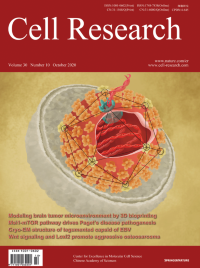
Advanced Search
Submit Manuscript
Advanced Search
Submit Manuscript
Volume 30, No 10, Oct 2020
ISSN: 1001-0602
EISSN: 1748-7838 2018
impact factor 17.848*
(Clarivate Analytics, 2019)
Volume 30 Issue 10, October 2020: 928-931 |
SARS-CoV-2 infects human neural progenitor cells and brain organoids
Bao-Zhong Zhang1,2 , Hin Chu3,* , Shuo Han1 , Huiping Shuai3 , Jian Deng1 , Ye-fan Hu1,4 , Hua-rui Gong1 , Andrew Chak-Yiu Lee3 , Zijiao Zou3 , Thomas Yau4 , Wutian Wu1,5,6 , Ivan Fan-Ngai Hung4 , Jasper Fuk-Woo Chan3,7 , Kwok-Yung Yuen3,7,* , Jian-Dong Huang1,2,*
1School of Biomedical Sciences, Li Ka Shing Faculty of Medicine, The University of Hong Kong, 3/F, Laboratory Block, 21 Sassoon Road, Pokfulam, Hong Kong, ChinaDear Editor,
Coronavirus disease 2019 (COVID-19) caused by the novel severe acute respiratory syndrome coronavirus 2 (SARS-CoV-2)1 has resulted in over 13 million confirmed cases and more than 580,045 deaths across 218 countries and geographical regions as of July 16, 2020. This novel coronavirus primarily causes respiratory illness with clinical manifestations largely resembling those of SARS. However, neurological symptoms including headache, anosmia, ageusia, confusion, seizure, and encephalopathy have also been frequently reported in COVID-19 patients.2,3 In a study of 214 hospitalized COVID-19 patients in Wuhan, China, neurologic findings were reported in 36.4% of patients, and were more commonly observed in patients with severe infections (45.5%).2 Similarly, a study from France reported neurologic findings in 84.5% (49/58) of COVID-19 patients admitted to hospital.3 Importantly, a recent study in Germany demonstrated that SARS-CoV-2 RNA could be detected in brain biopsies in 36.4% (8/22) of fatal COVID-19 cases,4 which highlights the potential for viral infections in the human brain. To date, there has been no direct experimental evidence of SARS-CoV-2 infection in the human central nervous system (CNS). We recently demonstrated that SARS-CoV-2 could infect and replicate in cells of neuronal origin.5 In line with this finding, we showed that SARS-CoV-2 could infect and damage the olfactory sensory neurons of hamsters.6 In addition, angiotensin-converting enzyme 2 (ACE2), the entry receptor of SARS-CoV-2, is widely detected in the brain and is highly concentrated in a number of locations including substantia nigra, middle temporal gyrus, and posterior cingulate cortex.7 Together, these findings suggest that the human brain might be an extra-pulmonary target of SARS-CoV-2 infection.
https://doi.org/10.1038/s41422-020-0390-x